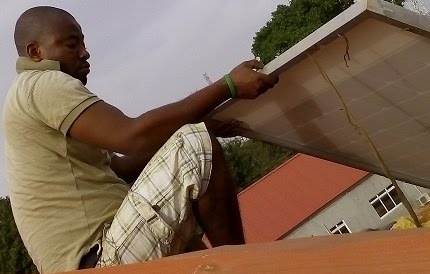How to make a very simple square
wave DC to AC power Inverter of 12v to 220v by yourself using few passive
and active components.
With this schematic circuit diagram, you can build a
very simple but powerful square wave DC to AC power inverter at home. I have
used this inverter system for more than 15 years to power drilling machines,
filament bulbs, televisions and fans electric iron. It is very active just that
some loads produces noise such as ceiling fan but it is a good inverter circuit
for both beginners and professionals. The noise produced by the fan or when
used with other inductive loads is because of the output waveform which is a
non sine wave. A 105/400v capacitor at the transformer output filters out the
noise a bit. The inverter produces a square wave as shown in the simulation
picture.
Things
you need
·
IC4069 integrated chip.
·
Electrolytic capacitor 1uf/50v and 4700μf/50v
·
Ceramic or Polyster Capacitor 1μf
(105)/400v
Irf250 MOSFET Preset: 50K
100k, 4.7k, 1k, 10k Resistor
Center Tapped Transformer, 12v or 24v depending on the battery voltage to be used.
12v Zener Diode
Vero board
Things to Try
· Connect a 50k variable resistor in
series with R2 and connect a frequency meter at the output of the transformer and then adjust the 50k
variable till you get 50Hz frequency.
·
To increase the wattage of the inverter, connect more
MOSFETs in parallel, it must be mounted on a heat sink and use a big
transformer.
·
Add a voltage regulator of 7812 to the 4069 IC to protect the IC. The 7812 voltage
regulator regulates the voltage to be constant 12 Volts only even when the
input voltage range is 12 volts to 24 volts.
The working principle
The circuit consists of an oscillator, buffer and
power stage. When a 12 volts battery is connected to the circuit, the IC converts
the battery voltage to AC of 12v. The AC signal is from pin 4. The first two Hex
inverter gates were connected as an actable oscillator circuit which is where
the power conversion takes place. R2 and C1 determine the output frequency of
the Inverter.
Buffer: Pin 6 output strengthen the
signal of the oscillator while pin 12 and 13 split the square wave oscillating
signal into two phases from the MOSFET power stage.
Power stage: The MOSFET and the transformer determine
the output power of the inverter. They drive the connected loads based on the
available power from the battery. The zener diodes connected to the MOSFET gate
to ground acts as a protector to the power stage.
For more information on this inverter, feel free
to comment on the post.
